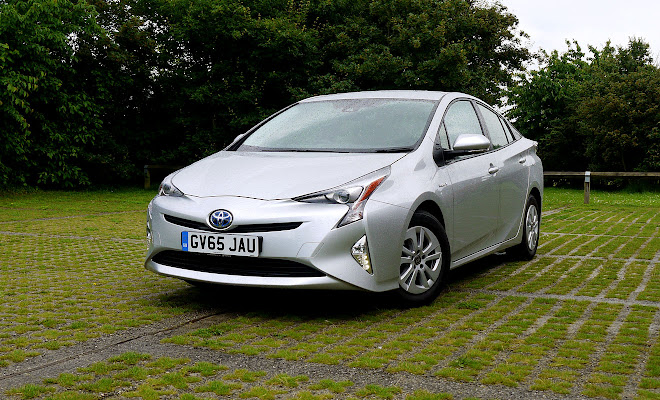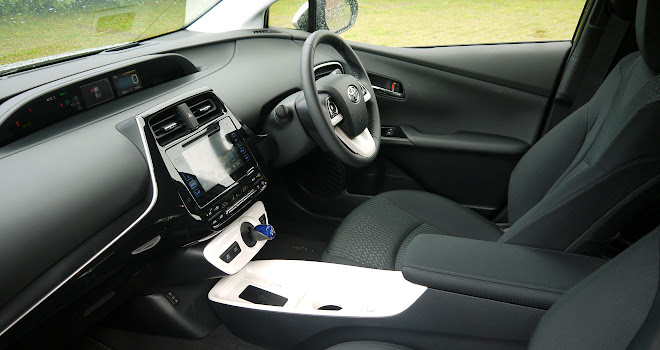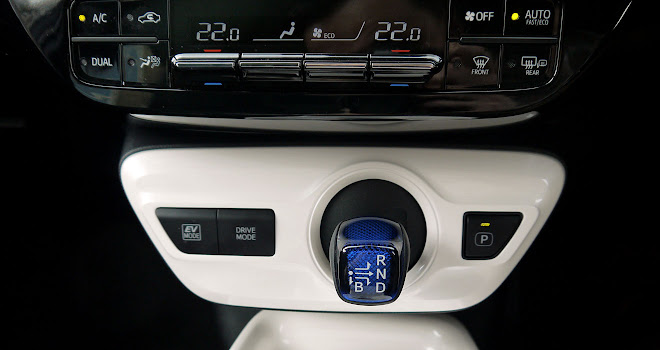
Rating: stars
Good: outstanding economy, comfort
Bad: divisive looks, patchy technology
Price: from £23,295
It’s been a while since anyone could accuse Toyota of building bland looking cars. Boring is not a word that seems apt when eyeing the fourth-generation Prius, but beautiful is not exactly leaping to mind either. Bold, though – it’s definitely that.
It’s a dramatic wedge of a car decorated with slashes, bulges and creases darting off in unexpected directions. It takes a while to grow accustomed to the weird design, but to my surprise I found myself genuinely liking the look during the week I spent driving the new Prius.
Unveiled at the Frankfurt motor show in September last year, the latest Prius made quite a splash. It ignored the refined, imperious look of 2012’s NS4 concept car, which at the time was assumed to preview the Prius 4, and instead took a few cues from the quirky FT-Bh concept that was also shown off that year (below).

The FT-Bh’s striking shape was inspired by the sails of yachts and by architectural fabric pulled taut with cables. You can find traces of these notions in the sharp points and tight curves of the new Prius lamp clusters, and in the way the corners of the roof stretch down towards the rear deck but don’t quite connect.
The Prius’s wheels seem to belong to a much less flamboyant car, however. They are four little lost 15-inch alloys, wrapped in 65-profile tyres and hidden, presumably for aerodynamic reasons, behind plastic covers. The small wheels do trim 6g/km from the car’s CO2 figure, compared to the 17-inch items filling the arches of plusher trim levels, which makes them a lot easier to love. Indeed, you can downgrade from the bigger wheels and save £400 if you want top of the range features with ultimate economy.
And you’ll have to shed the bigger alloys to duck under the 75g/km threshold that confers exemption from the London Congestion Charge.

When equipped with 15-inch wheels, the Prius’s official CO2 score is 70g/km, a remarkable result for a car of its size and capability. Nothing else touches it without resorting to a mains cable and plug.
The official combined-cycle consumption result is 94.1 mpg. I didn’t achieve that kind of economy with my motoring, but I did manage better than 60mpg during a congested slog from one side of London to the other, on a hot day with aircon running, and at an average speed you might have calculated with a sundial and calendar.
Such impressive inner-city thrift should secure the Prius’s position as the minicab driver’s best friend. Indeed you can opt for a taxi pack when ordering your Prius, complete with wipe-clean faux-leather seats.

It’s also a supremely comfortable car during extended hours in congestion and is a doddle to push along in stop-start traffic. If you suffer from bouts of road rage, a Prius could well be the cure.
Inside, you sit low, flanked by deep windows and placed a long way back from the windscreen. It’s a very different feel to previous generations of the car, going right back to the 1997 original Prius, which sat you up a lot higher and felt less involving as a result.
There’s plenty of space in the back, though not a great deal of headroom. The fourth-generation Prius is a little lower, longer and wider than the car it replaced. Happily there is the option to carry a spare wheel rather than a can of gunk in the boot, though that might be the reason the 457-litre luggage area seemed a little small and shallow to me, under its rollerblind cover.

The new interior seems solidly built and proved free of rattles. There are appealing little touches such as the name Prius etched into the chrome centres of the air vents, to help you feel you’ve chosen a car with integrity. The seat heater switches, buried out of sight and almost out of reach, may tend to undo that impression, however.
A plastic central tray and matching steering wheel flourishes are also questionable items, seeming oddly out of kilter among the rest of the sober materials. The tray does incorporate a wireless charging mat, using the Qi format, which alas my phone doesn’t support. There are USB ports, thankfully, and I also found it trivial to connect my phone via Bluetooth to receive calls on the move.

The instrument panel is an extended horizontal strip filled with crisp and colourful graphics, plus Toyota’s signature crappy digital clock. It’s all offset towards the centre of the car which would be annoying if it weren’t for the bright head-up display that features on all models except the base Active trim.
The HUD is pared back in what it shows but works brilliantly, painting your speed onto the base of the windscreen along with either the speed limit or a demand gauge designed to help you drive more economically.
If you stray above the speed limit, the HUD will alert you with a red and blinking roundel. The car can also announce over the stereo that you’re speeding, though I only had my knuckles rapped once and the car was mistaken. Honestly officer.

Indeed the Prius very often muddled up its speed advice. As standard, the car includes visual road-sign recognition to spot speed limit signposts as you drive along. The speeds it shows aren’t always the same as the limits displayed by the satnav, giving a choice of two.
Adding further confusion, the Prius did from time to time decide that the limit was 90 or 110, which confused me until I realised the car was spotting km/h speed stickers on the backs of foreign trucks. It’s an easy mistake to make if you’re a machine and don’t have any common sense.
When not perplexed by befuddled tech, I found the Prius relaxing and easy to drive. It retains the usual peculiarities that will be familiar to anyone who has driven a previous generation of Toyota’s flagship hybrid. The parking brake is foot operated, for example, and the gear selector is a stubby, spring-loaded wand.

You never have to think about managing the car’s clever powertrain – it just gets on and makes decisions for you, aiming to minimise fuel consumption. There’s a 1.8-litre, four-cylinder petrol engine under the bonnet, providing up to 97bhp and 142Nm of torque, alongside a 53kW (71bhp) electric motor that can summon 163Nm. With motor and engine combined the Prius can reach 62mph in 10.6 seconds, though it feels especially brisk away from a standstill, due to the electric motor’s low-speed muscle.
The engine and motor are connected to the front wheels via a fiendish set of cogs that can juggle the power flows in several different ways. The engine and motor can join forces to propel the car, or either one can drive the car along on its own. The engine can also drive the car whilst charging the battery at the same time, or the car’s momentum can send power to the battery while the engine switches off.
As with older Prius models, the engine revs tend to reflect how hard you’re accelerating rather than how fast you want to go. Toyota has tweaked the response a little with this fourth generation, however, so the car sounds a little more conventional as you speed up. This removes the unnerving sensation of waiting for something to happen, which could often seem off-putting in the previous Prius.
You’ll still hear the engine doing unexpected things, such as revving with peculiar vim when you’re pootling along at middling pace. That’s presumably because it will be more efficient at that moment to drive the car and charge the battery simultaneously. After a while the engine will switch off, and the motor will spend what charge the engine just accumulated.

Most of the time the car will set off in silent electric mode, with the engine quickly joining in as speed rises. The engine’s throaty growl will then die away to nothing as you start to slow. It can be quite difficult to bring the new Prius to a smooth and clean stop, however, at least in the car I tried. The brakes would always grab in the last yard or two, presumably as the regenerative phase of braking came to an end.
There are several driving modes to play with. Eco mode feels as if you’re towing a tank and is not a mode I’d recommend. While I welcome the notion of saving fuel, I’d prefer to be able to exit junctions without any moments of panicky fear. Power mode, by contrast, creates a lot of extra noise and a small amount of extra go. Normal mode is by far the better bet.
There is also an EV mode, which doesn’t last very long or take you very far. Dab too much at the throttle and the Prius will switch back into normal hybrid mode.
Visibility is generally good, though the steeply raked screen pillars do intrude a bit, on the approach to roundabouts or when spotting pedestrians poised at zebra crossings. The rearward view in the mirror is also bisected and not very helpful in the rain, though a reversing camera is standard across the range.

Radar cruise control also comes as standard, accessed via a stubby controller poking out from the hub of the steering wheel. It works well most of the time, though it did overreact once for me while passing a queue of traffic exiting the motorway – braking quite sharply at nothing at all in the lane ahead. Similarly, the collision early warning radar tended to sound its klaxon whenever there were cars parked at the side of a narrow curving road.
Despite these tendencies to cry wolf, I think I’d still prefer a car that gave false alerts than no warnings at all.
Most of the time, the new Prius feels like what it is – an intelligent car doing wise things to save fuel. It’s comfortable, reasonably quiet and feels equally at home in choked traffic or on the motorway.
It’s not pretty, but it is clever.




